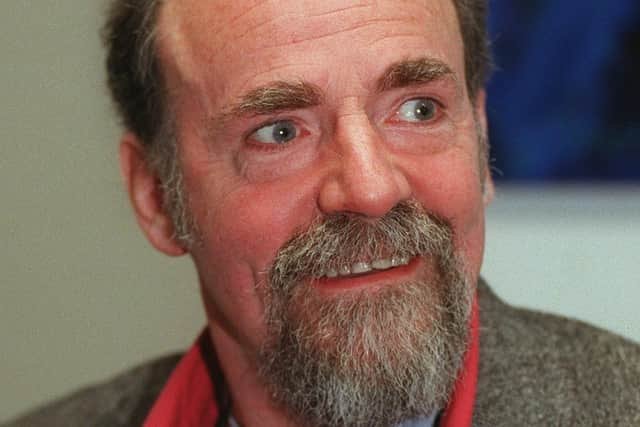Obituaries: Dawson Murray, accomplished artist and inspirational teacher
The death of the artist and teacher Dawson Murray at the age of 78 has robbed Scotland of one of its most accomplished creative talents and inspirational voices. Murray died after a short term in hospital but he had suffered from multiple sclerosis for several decades. He had spent much of that time confined to a wheelchair. Despite that, his creative output and enthusiasm were undiminished – he carried on making art that continued to evolve, deepen, mature and grow. The total dedication of his wife, Liz – and Murray’s perseverance and ingenuity – enabled him to achieve this, against all the odds.
Murray was born in Springburn, Glasgow where he attended Albert Secondary school before entering Glasgow School of Art, in 1961. His mother, Helen (Ella) née Bissett, worked in a munitions factory and his father, also Dawson, was a locomotive engineer.
Advertisement
Hide AdAdvertisement
Hide AdMurray excelled at art college where, after graduating, he was awarded a Carnegie Travelling Scholarship. It was during part of this sojourn, while in Sicily, that he proposed marriage by telephone to his then girlfriend, fellow artist Elizabeth Barnet, whom he had met in Glasgow in 1965. The couple were married in Palermo in April, 1967. Murray spent two years in Italy, firstly in Venice where he studied at the Academy of Fine Arts under Giuseppe Santomaso (1907-1990), the greatly respected anti-fascist artist and teacher. The newly-weds lived in the centre of Palermo before moving to the village of Villagrazia. Murray went early to catch the morning light, drawing the landscape on sheets of fine sandpaper with pastels. When a massive earthquake hit the area in 1968 the couple spent a week sheltering in a henhouse with their neighbours. The sight of the nonne counting their rosaries did not reassure them.


After returning to Scotland, Murray began working as a teacher in the east end of Glasgow and, later, in Dumbartonshire. In 1977 he was appointed head of art at the newly-opened Boclair Academy in Bearsden. His time at Boclair, where Murray was a popular teacher and colleague, was immensely fruitful. He was responsible for inspiring many students, including the Glasgow-based artist and professor, Ross Sinclair. Writing to Murray in 2015, Professor Sinclair commented: “I remember so clearly when you were my teacher and would assess my work. It was the very beginning of my understanding of art. I will always be very grateful that you were there to lead the way and show me how it could be done. Perhaps if you hadn’t been there I wouldn't be here now.” Sinclair said that the art department was unusually well equipped and that senior pupils were encouraged to experiment and explore different media and techniques. He is convinced that these foundations underpinned his own successful career.
As his MS worsened, Murray retired from teaching in 1995, and moved to an 18th century cottage in the village of Kilmany in Fife. Here, the couple, with their two daughters Bryony and Cecily, quickly became popular and valued members of the community. Liz and Dawson together designed and built a purpose-made studio and developed the cottage’s garden, which was to become an increasingly important part of Dawson’s artistic and spiritual life.
As Dawson’s MS took hold, affecting his mobility, speech and other motor functions, he began to rely increasingly on a series of artistic assistants and collaborators. The role of these colleagues was complex but mainly involved their ability to interpret and execute Dawson’s ideas and instructions in the process of printmaking. Emily Fong, who worked with Dawson from 2017 to 2018, helped Dawson achieve his artistic aims through her own finesse and experience and noted Murray’s extraordinary patience, optimism and joy.
Murray’s passion was aquatint and he personalised the ‘sugar-lift’ technique which allowed him to combine elements of both printmaking and watercolour painting. He applied the unlikely combination of syrup and gouache to a wet metal plate which was then covered with an acid-resistant varnish. The plate was then immersed in hot water causing the sugar solution to expand and break through the varnish. By such a process he painstakingly created imagery which was then inked and printed, although the plate was reworked many times to achieve the desired result. Chance elements created by capillary action on the plate mimicked the poetic fluidity and randomness usually only achieved by the watercolourist. Murray’s imagery and inspiration came to be increasingly drawn from his garden and he would often sit for hours taking in its atmosphere and subtle changes of light and shade, insect behaviour, colour, movement and sounds, all of which he absorbed with a sense of wonder and gratitude. Many of these nuanced feelings and sensory perceptions, inevitably augmented and enhanced by his physical disability, made their way into his sumptuous, sensitive, but bold, artwork.
In the earlier parts of his career, Murray collaborated widely with artists and organisations, including The Richard Demarco Gallery, where he served on the board, with others including the artist George Wyllie (1921-2012), in the late 1970s and early 1980s. While at Boclair, Murray invited guest speakers to the school, including Demarco; the Demarco connection also brought him into contact with the German avant-gardist, Joseph Beuys (1921-1986) whose work, New Beginnings are in the Offing, he helped install, with Wyllie, at the Scottish National Gallery of Modern Art.
Murray also developed a number of other important international connections and he exhibited with the famous Galleria del Cavallino in Venice in 1983 and, in 1990, at the International Drawing Triennale in Wrocław, Poland.
Murray is survived by his wife, Liz Murray, their daughters Bryony and Cecily, and his grandchildren Marion and Isla.
Obituaries
Advertisement
Hide AdAdvertisement
Hide AdIf you would like to submit an obituary (800-1000 words preferred, with jpeg image), or have a suggestion for a subject, contact [email protected]
Subscribe
Subscribe at www.scotsman.com/subscriptions
Comments
Want to join the conversation? Please or to comment on this article.